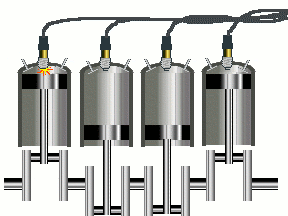 | ||
Engine displacement is the swept volume of all the pistons inside the cylinders of a reciprocating engine in a single movement from top dead centre (TDC) to bottom dead centre (BDC). It is commonly specified in cubic centimetres (cc or cm3), litres (l), or (mainly in North America) cubic inches (CID). Engine displacement does not include the total volume of the combustion chamber.
Contents
Definition
Engine displacement is determined from the bore and stroke of an engine's cylinders. The bore is the diameter of the circular chambers cut into the cylinder block.
Or in decimal form:
Examples: The 427 Chevy bore is 4.312 in, and the stroke is 3.65 in, therefore the displacement for this eight-cylinder engine is:
3.1416/4 × (4.312 in)2 × 3.65 in × 8 = 426.4 cu inor:
(4.312 in)2 × 0.7854 × 3.65 in × 8 = 426.4 cu inIf the bore is 10 cm and the stroke is 5 cm with four cylinders, the calculation is:
3.1416/4 × (10 cm)2 × 5 cm × 4 = 1,570 cm3 = 1.57 litresUnits of measure
In the United States, the cubic inch was the commonly used unit of measurement until the 1980s by the manufacturers to express the displacement of engines for cars, trucks, etc. (e.g., the "426" in 426 Hemi refers to 426 cubic inches displaced). It is still used for this purpose in the context of the classic-car hobby, auto racing, and so forth.
The automotive industry currently uses the International System of Units / le Système international d'unités (SI), a modern metric system for this purpose worldwide (e.g. 6.1 litre Hemi). However, in markets accustomed to cubic inches, the actual displacement measurements of an engine are still given by many manufacturers in these units, usually along with metric value; e.g. the 6.1-litre Hemi's published displacement is 370.0 CID/6,059 cc. Some examples of common CID-to-litre conversions are given below. Note that nominal sizes are not always precisely equal to actual sizes. This principle is frequently seen in engineering, tool standardization, etc. (for ease of use) and in marketing (when a big round number sounds more impressive, is more memorable, etc.).
Governmental regulations
Taxation of automobiles is sometimes based on engine displacement, rather than power output, fuel economy, or emissions. Displacement is a basic fundamental of engine design, whereas power output depends a great deal on other factors, particularly on how the car manufacturer has tuned the engine from new. This has encouraged the development of other methods to increase engine power, such as variable valve timing and turbochargers.
There are four major regulatory constraints for automobiles: the European, British, Japanese, and American. The method used in some European countries, and which predates the EU, has a level of taxation for engines over 1.0 litre, and another at the level of about 1.6 litres. The British system of taxation depends upon vehicle emissions for cars registered after 1 March 2001, but for cars registered before this date, it depends on engine size. Cars under 1549 cc qualify for a cheaper rate of tax.
The Japanese method is similar to the European taxation by classes of displacement, plus a vehicle weight tax.
The United States does not tax a vehicle based on the displacement of the engine (this is also true in Canada, Australia, and New Zealand). Engine displacement is important in determining whether or not smaller vehicles need to be registered with the state and whether or not a license is required to operate such a vehicle. A common threshold is 50 cc.
In the Netherlands road tax is also based on region and fuel type (petrol / CNG, LPG, Diesel, or other (electric/hybrid/H2)) and in Sweden, road tax is based on vehicle weight. However, Swedish cars registered in 2008, or later, are taxed based on carbon dioxide emissions.
Displacement is also used to distinguish categories of (heavier) and lighter motorbikes with respect to driving licence and insurance requirements. In France and some other EU countries, mopeds of less than 50 cm3 displacement (and usually with a two-stroke engine), can be driven with minimum qualifications (previously, they could be driven by any person over 14). This led to all light motorbikes having a displacement of about 49.9 cm3. Some people tuned the engine by increasing the cylinder bore, increasing displacement; such mopeds cannot be driven legally on public roads since they no longer conform to the original specifications and may go faster than 45 km/h.
Wankel engines, due to the amount of power and emissions they create for their displacement, are generally taxed as 1.5 times their stated physical displacement (1.3 litres becomes effectively 2.0, 2.0 becomes effectively 3.0), although actual power outputs are far greater (the 1.3-litre 13B can produce power comparable to either a 3.0 V6 engine or a turbocharged 2.0 inline-4 engine, and the 2.0-litre 20B can produce power comparable to a 3.5 to 3.8 V6 engine or a 4.0 V8 engine). As such, racing regulations actually use a much higher conversion factor.
Automotive model names
In the automotive industry, engine displacement is frequently encoded in the auto manufacturer's model names. For instance, Nissan's Teana 350JM is a car with a 3,498 cubic centimetres (213.5 cu in) displacement engine. Motorcycles are often labeled similarly. However, this can be misleading. For instance, the BMW 335i only has a 3.0-litre (twin-turbocharged) engine, the Bugatti Veyron 16.4 has an 8.0-litre (quad-turbocharged W16) engine, and the Lamborghini Gallardo LP560-4 has a 5.2-litre engine (with a maximum power output of 560 PS). Lexus hybrid vehicles (h) are marked higher than true engine size to signify the extra power from auxiliary systems. (Examples: RX450h has a 3.5 L engine, LS600h has a 5.0 L engine.)
